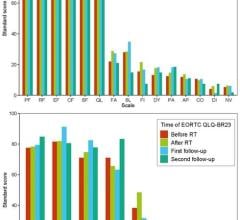
February 6, 2017 — Onxeo S.A. and the Institut Curie launched a series of studies on World Cancer Day (Feb. 4) aimed at investigating the benefits of combining radiotherapy, DNA repair inhibitors and immunotherapy. This highly innovative combination would make it possible to reverse the disease in patients suffering from drug-resistant cancers.
In 2016, Onxeo, a French biopharmaceutical company specializing in the research and development of new treatments for orphan cancers, acquired AsiDNA, a signal-interfering, DNA-repair-pathway inhibitor based on the DBait technology, which was discovered by the Institut Curie.
A number of ongoing studies (more than 2001) that combine radiotherapy and immunotherapy are currently evaluating the effectiveness of this combination in the treatment of various metastatic or advanced cancers such as lung, esophagus, brain and prostate cancers, as well as melanoma, leukemia and sarcoma. As an example, recent trials have demonstrated the benefits of combining radiotherapy with ipilimumab (PD1-targeted immunotherapy) in metastatic melanoma: Increased survival and complete responses were observed in patients who received this double treatment.
Immunotherapy is undeniably a new weapon of choice against cancer. However, despite impressive results against some tumors, 80 percent of patients do not respond to these new therapeutic strategies, according to the institute, the most advanced of which are PD1 and PDL1 inhibitors.
“Patients for whom new immunotherapies are ineffective generally suffer from types of cancer that have low-level DNA mutations and do not produce neo-epitopes. These small, cancer-specific molecules, which carry the mutation of a gene specific to the tumor cell, set the immune system on high alert and propel it to track down the dangerous cells,” explained Sebastian Amigorena, director of the Immunotherapy Center at the Institut Curie.
The limitations in the efficiency of the new immunotherapies seem related to DNA alterations and, most likely, to the tumor’s capacity to repair its lesions, even if only in a residual way. Marie Dutreix, research director at the Institut Curie (Orsay site), is a renowned specialist in DNA repair mechanisms2 and the researcher behind a new class of very promising products, including the Dbait agents, which boost the effect of genotoxic treatments such as radiotherapy by diverting the enzymes meant to repair the DNA of cancer cells from their target, among other ways.
The combination of radiotherapy and Dbait agents has already shown very promising results in humans. The DRIM clinical study3, performed in patients with skin metastases from melanoma, demonstrated that AsiDNA (the clinical form of Dbait) was well tolerated by patients when administered locally, with complete response rates (disappearance of tumor nodules) four times higher than those observed with radiotherapy alone.
With Onxeo’s team, doctors and researchers from the Institut Curie will combine their expertise to evaluate the combination of immunotherapy with radiotherapy and AsiDNA.
Concretely, this combination would work as a virtuous circle, each therapeutic approach contributing to the effectiveness of the others:
- Radiotherapy induces the death of tumor cells, which stimulates the expression of inflammatory response genes and, therefore, the immune system response;
- AsiDNA aims to amplify the effects of radiotherapy by preventing damaged tumor cells from repairing their DNA. It therefore increases the effectiveness of radiotherapy and the “immunogenic death of tumor cells”; and
- Immunotherapy increases the ability of the immune system to recognize and destroy tumor cells.
Clinical trials combining radiotherapy and immunotherapy have already demonstrated the efficacy of this combination. This new triple combination could help reach a new stage in the fight against cancer.
For more information: www.curie.fr/en


 March 28, 2024
March 28, 2024 








